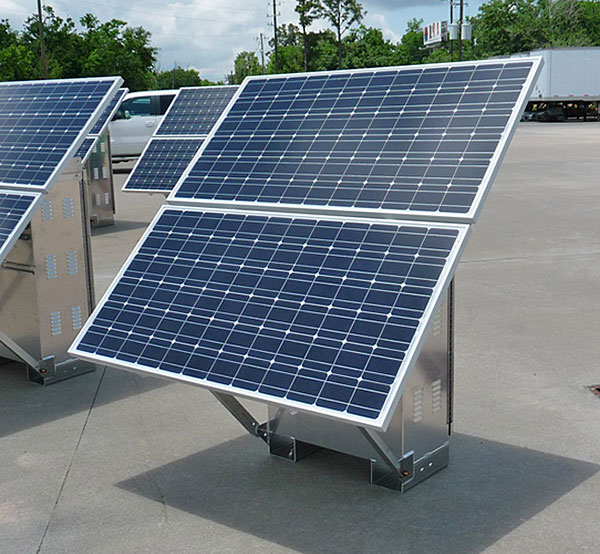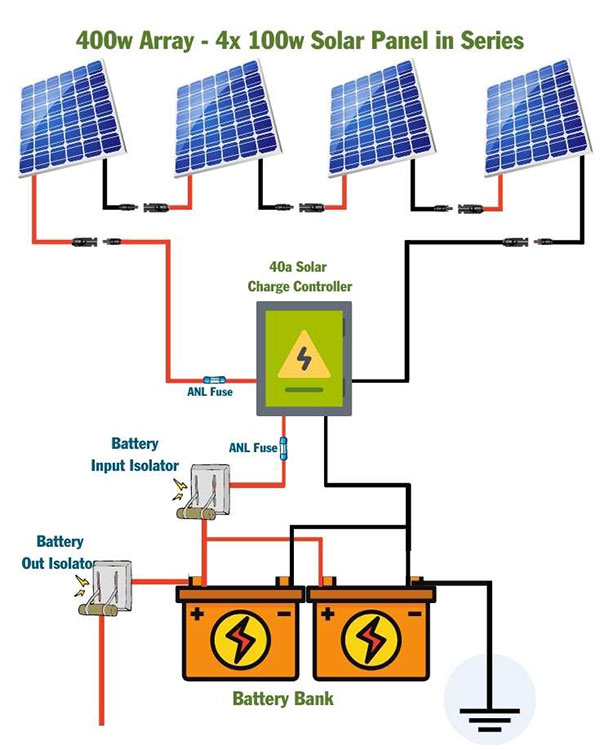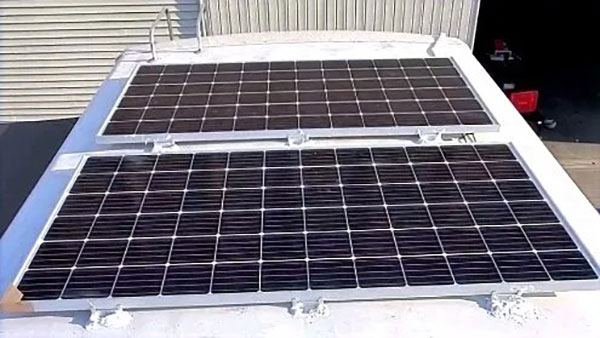Description of 400-Watt Solar Panel
A
400-watt solar panel is considered to be a
powerful tool in the sphere of renewable energy. With a capacity to produce approximately 400 watts of power under the optimal conditions, it can be used for reducing the costs of electricity substantially. Moreover, these devices are
user-friendly and suitable for application in both residential and commercial settings.

Daily and Annual Energy Production
The quantity of energy produced by a 400-watt solar panel daily and annually is determined by several factors, including the location, the orientation, and the level of pollution. A single 400-watt panel in direct sunlight produces approximately
1.6 to 2.4 kilowatt-hours of energy. Consequently, the annual output can be approximated to
584 to 876 kilowatt-hours if there are 4-6 peak sun hours. It is important to take into account that these figures largely depend on the degree of pollution because clean air and fewer clouds increase the level of sunlight the panel receives. Simultaneously, the results may differ throughout the year because the summer months are able to produce a higher output.
Impacts of Other Environmental Factors
Apart from the above-mentioned factors, there are other pollutants and environmental aspects that have a substantial impact on power output by the solar panels. Shadows on the panel can be produced by surrounding buildings or trees, dust, and bird dropping. Each of them can greatly hamper the efficiency. At the same time, there is evidence that solar panels work best and produce substantial outputs if the weather is sunny and cool. Hence, high temperatures can reduce the efficiency by
10 – 25% depending on the type of the technology used. Finally, the angle and the orientation affect the results because most energy is produced if a panel is oriented towards the sun. For instance, in the Northern Hemisphere, the southern orientation is the best option.
Solar Panel Compatibility with Devices
Whether or not a 400-watt solar panel is compatible with devices depends on understanding the energy requirements of those devices. For example, household refrigerators might use anywhere between 1-2 kWh of energy per day. This means, on a sunny day, a single panel might be able to power such a device. When it comes to more power-hungry devices or entire households, several panels can be connected in a series or parallel. Essential compatibility considerations include the voltage and current output of the devices and the overall energy consumption pattern of the home or facility. In order to make the best of a 400-watt solar panel, it might be a good idea to conduct an in-depth energy audit that should provide an explicit answer as to the energy needs of a given home or facility, so that the solar power system is designed to meet those needs, making renewable energy a viable addition to everyday life.

Key Specifications of 400-Watt Solar Panels
A 400-watt solar panel is engineered to strike the optimum balance between size and energy output, and, thus, is an excellent choice for those who want to produce as much energy as possible without taking up a disproportionate amount of space. Typically, such panels might have an efficiency rate ranging between
15% and 22%. This means that, of the sunlight the panels are exposed to, they convert between 15% and 22% into electricity. The exact rate depends on the material and design, with monocrystalline panels typically being on the higher end of the efficiency spectrum.
Solar Panel Efficiency
Efficiency is one of the primary concerns associated with the use of 400-watt solar panels. Notably, it is the portion of sunlight that can be turned into usable electricity. A higher percentage of efficiency allows for generating more electricity with the same quantity of sunlight. In the context of these solar panels, a unit that has a
20% efficiency rating signifies that it is reasonably effective and efficient due to its ability to exploit about one-fifth of the sunlight. Consequently, 400-watt solar panels with such an index are a solid pick for residents aiming to generate large amounts of electricity without considerable investments into equipment or having to rely on traditional grids. Dimensional Differences and Weight On the same note, 400-watt solar panels may also differ in dimensions, with the common ones being around
79 inches by 39 inches. However, based on the manufacturer and the composition of associated solar cells, the mentioned sizes may slightly differ with some of the panels leaning towards a longer or narrower shape. Furthermore, such equipment’s weight mostly varies within the critical ranges of
50-60 pounds, as it allows for installing the majority of house roofs without having to reinforce them. Life Expectancy and Durability. One of the advantages of this type of equipment is that it is designed to last, and manufacturers usually warranty their operation up to
25-30 years expecting them to only lose
20% of their initial operational capacity over the time. The equipment can endure some of the strongest winds and heaviest snow loads, and it can suffice to say that owners can buy these solar panels with a surety of returning the invested money multiple times next three or four decades.
Selecting a 400-watt solar panel involves choosing a product housing high efficiency, manageable size, and durability. Not only does the product rule over current energy demands, but it will help to ensure a cleaner future. The benefits of 400W panels make them the best choice for both homes and businesses as they offer a green energy solution. Such a decision is a step to a cleaner and more sustainable future.
Home Solar Power with 400W Solar Panels
When it comes to using 400-watt solar panels for home, such a solution presupposes a logical step toward independence and sustainability. Home consumption will be significantly reduced while the users will be able to power everything from heating systems to behavioral habits with a more efficient solution. The reduction in emissions is another benefit allowing the users to receive an additional advantage from cutting utility bills.
To calculate the exact number, one should analyze monthly usage that is usually calculated in kilowatt-hours. For example, in the United States, the average power consumption of a standard family is around
877 kWh per month. Each 400-watt solar panel will provide approximately
1.6 – 2.4 kWh of electricity per day, depending on the weather, which should be enough for a family in a less cloudy place. Therefore, the calculation should be carried out monthly consumption by monthly production by a single panel. As a result, the household needing 877 kWh per month in an area with an average of 5 peak hours per day, it will need around
20 – 30 panels to house the demand for electricity.
Appliances a Single 400-Watt Panel Can Run
One 400-watt solar panel can enable the operation of several small to medium-sized appliances or a combination thereof through several hours. Primarily, a
LED light, a
laptop, and a
small refrigerator may operate throughout the day during sun time. To be more specific, the laptop consumes no more than 60 watts per hour and can be utilized for a maximum of approximate
6.5 hours throughout the day using the energy produced by the panel under the light conditions. Therefore, it is applicable to power essential electronics to support off-grid or supplement home energy needs.
Calculating System Size Based on Energy Usage
The assessment of the future solar power system requires the consideration of actual home energy consumption, average peak sun hours for the place of living, and solar system panels’ efficiency. In more detail, it starts with collecting information on the total energy consumption of the household over the past year in the form of a wide range of considerations. Later, to calculate the average kWh per day, the figure should be divided into
365 number of days per years. Finally, considering the average number of peak sun hours, it is necessary to find the total wattage provided by the solar panels throughout the day. Thus, hypothetically, an average family home consumes approximately
877 kWh per month or about
29 kWh per day across the United States. Therefore, the sample system size is supposed to be divided across five peak sun hours:
29/5 = 5.8 or more specifically
5 to be adapted to the average efficiency of the solar panel system. Overall, the usage of 400-watt panels not only protects the environment but gives a sense of empowerment. That’s why it is important that the alternative energy source should become the most vital part of home operational needs with careful consideration.
Solar energy is a perfect way to power your home with electricity. As the efficiency and availability of solar panels, including 400-watt modules, are growing, using the electricity generated by the sun becomes even more accessible. In this paper, I will describe how to power your home with 400-watt solar panels by estimating the number of necessary modules, explaining which appliances you can operate, and specifying a system’s size for a given energy expenditure.
Powering Your Home with 400-Watt Solar Panels
Choosing 400-watt solar panels to power your home is an excellent and environmentally friendly solution for the present and the future. Owing to the balance between the power output and efficiency, they can be used to meet a wide range of residential electricity demands. Furthermore, as a result of switching to solar energy, your monthly bills will become lower, and you will have a direct positive impact on the environment toward cleaner and more sustainable electricity.

Estimating Number of Panels for Home Use
To calculate the number of 400-watt solar panels that you need for home use, you have to know how much energy you usually consume. In the United States, an average household uses about
877 kWh per month. Considering that one panel generates between
1.6 and 2.4 kWh of electricity a day and
720 to 1,100 per year, depending on a number of solar hours, you should calculate your average monthly consumption by dividing it by the amount of electricity one panel produces a day and modify it by the average amount of sunlight in your area. You must also consider and leave a cushion for seasonal variations.
Using a 400-watt solar panel to power your home is a promising solution because of its optimal combination of the power output and efficiency. To estimate the number of required modules, it is important to understand the amount of electricity you usually consume.
small (in case you may want to run a few LED lights and charge a laptop at the same time)
medium (you can run a fridge or an installation/charge batteries with a peak no-load current of up to 20A (like charging your car system)
Please note that you would still need to figure out the size of a system that can meet the total energy needs of your household. In fact, you will need to calculate the total energy consumption of your household per year and, based on this data, work out the average daily consumption, and figure out how much energy your solar panel will need to generate during daylight hours to cover these needs. The ultimate goal of switching to solar should be to match your household energy consumption with your solar panel’s energy production features, which will allow you not to worry about any additional energy storage/supply solutions at night and on days with no sunlight. Thus, since a solar panel with 400 watts will run and benefits you for sure, you need to learn to look at solar power in a proper and adequate manner. At the same time, please remember that going solar is not just installing a solar panel on your house. Instead, it is a commitment to a different, more efficient, and carbon-free way of consuming energy.
Common Applications and Uses
With solar energy being increasingly established as a staple in the global transition to renewable energy, 400-watt solar panels are leading the pack in both efficiency and versatility. From homes to remote locations that lack traditional electricity or rely on unreliable sources, these panels are shaping up to be a solution that can be tailored to any setting. The wide range of uses for this power source reflects its growing potential as the path to cleaner energy solutions in the future. Residential and Commercial Installations
In both the residential and commercial sectors, 400-watt solar panels are popular for their properties as a power source that can provide a substantial portion of daily energy consumption in either setting. In homes, it is entirely possible to go as far as nearly or entirely eliminating electricity costs spent on running appliances and lighting homes in both sunny and less sunny areas. This application is of high potential for commercial buildings both as an investment that can reduce costs of running the business and as a green energy source that reduces the negative environmental effects of electricity production that can be beneficial for the company’s image. The resulting installations can be as small as a few panels or as large as solar farms. Recreational Vehicles and Off-grid Living
For fans of recreational vehicles or off-grid living, 400-watt solar panels are an essential item that can offer freedom without sacrifice. These panels, when used on an RV, can effectively power appliances and lights in the vehicle. When used in off-grid living, they open up more opportunities for people that live in cabins, tiny homes, or homesteads that were previously more difficult to power. The implications are that off-grid living is enabled and by proxy even more sustainable with each individual generating their own power directly from the sun.
Special Use Cases: Solar Pumps and More
In addition to general power generation, 400-watt solar panels are used to provide power supply for special applications, such as running solar pumps in the field of agriculture. By doing so, farmers are able to reduce their use of diesel generators and the grid and run their equipment on the renewable form of energy . Furthermore, solar panels are used for the maintenance of the telecommunication support infrastructure and power the remote relay stations . Thus, the USSG 400-watt panel’s use is diverse and showcases the flexibility of panels and the solar energy industry.
Transitioning to solar panels that are powered by the sun is not only an investment that helps one save on electricity bills. Instead, it signifies support for renewable forms of energy and sustainable development of electricity. Whether it powers a house of a family of four or a greenhouse, a canteen or an RV, a 400-watt solar panel is a feasible, functional, and efficient means for meeting one’s power supply needs.


